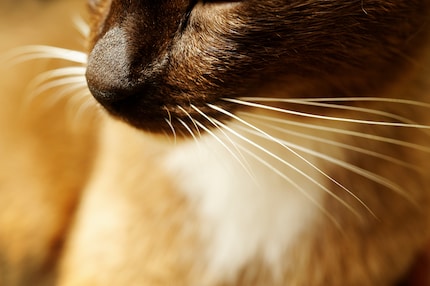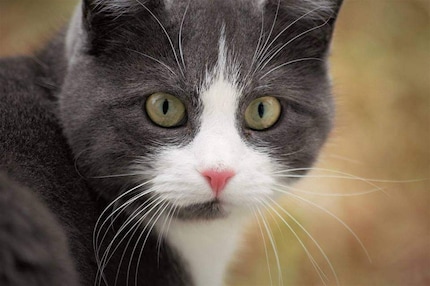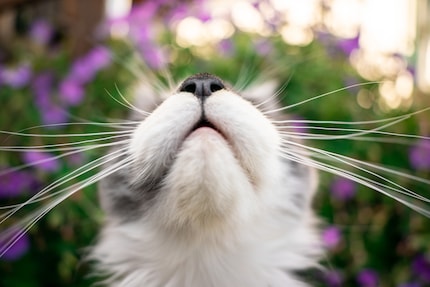
Background information
Practise ’til it clicks: how to teach your cat tricks with the clicker method
by Darina Schweizer

Have you ever seen a cat without whiskers? Probably not, and there’s a reason for that. For us humans, the moustache is a personal preference, but for cats it’s vital.
«Daddy, what’s this?» my daughter asked the other day, as she held out a white hair she’d found on the floor. It couldn’t be one of my grey beard hairs, it was far too long, thick and bristly for that. It was probably a whisker one of our four cats lost.
I once read somewhere that it’s said to bring good luck and wealth if you find a cat’s whisker and carry it with you. That’s superstition, of course. What you can believe, are the following five facts.
The whiskers aren’t just for aesthetics. They’re actually highly developed and touch-sensitive tactile organs that are precisely tuned. The whiskers are usually the same length as the cat is wide. That way, the animal always knows whether it’ll fit through a tight space. The whiskers also detect even the slightest breeze, which helps them to search for prey, among other things. This is what makes the cat a successful hunter, moving purposefully, gracefully and with lightning speed.

Whiskers are particularly helpful late at night. They play a crucial role in nocturnal navigation, even though cats can see in low light. Using the whiskers as a kind of third eye, the cat can get an idea of its surroundings spatially, even when it’s dark. When it moves around a room, its whiskers graze walls, furniture and other objects. And this gives the cat an accurate picture of its surroundings.
The whiskers on the nose and snout aren’t the only ones on the cat’s head. They also have some on their cheeks, chin, upper lip and above their eyes. The ones above their eyes act as protection for their sensitive eyes as much as possible. They tell the cat whether something is in front of or close to its face. If the whiskers touch something, this triggers a reflex and the cat closes its eyes.

Even though whiskers look like antennae, they’re actually also a means of communication. You can read your cat’s mood from them.
They’re happy: Your cat’s whiskers are pointing forward. With one exception: if your cat’s excited because it’s spotted prey or an enemy, its whiskers also point forwards.
They’re calm and relaxed: Your cat’s whiskers are perpendicular to the nose, i.e. straight to the side.
They’re afraid or feel uncomfortable: Your cat presses its whiskers against its cheeks.
When I think of the cat’s whiskers, I can’t help but think of the story of Samson, one of the biblical superheroes. As God’s chosen one, Samson had superhuman strength and was considered invincible. That was until his lover Delila cut off his long hair (which gave him his strength) while he was sleeping.
Its a similar situation with cats because without their whiskers, they wouldn’t be anything like what they are and that makes them special. Therefore:
Never cut off your cat’s moustache!
Until the whiskers have grown back, your cat will be unnecessarily confused, frightened and disoriented. In other words it would be animal cruelty.
The same applies to certain cat breeds that have little or no whiskers for genetic reasons. They’re missing an important sensory organ. This is one of the reasons why animal rights activists refer to the breeding of hairless cats such as the Sphynx as torture breeding. The animal protection organisation «Vier Pfoten» has compiled a good overview of the different types of cat breeds here (link in German).

Since they grow back, we don’t have to worry about the whisker our daughter found on the floor. It’s quite normal for a cat to lose one from time to time, even if they’re rarely discovered. Nevertheless, we didn’t keep the whiskers as a supposed lucky charm. But now I understand how this superstition came about. Something that gives a cat such valuable abilities could have a positive effect on humans ... Hm, maybe I’ll look in the garbage for the whisker that fell out after all.
Header image: Shutterstock / fantom_rd
I'm a full-blooded dad and husband, part-time nerd and chicken farmer, cat tamer and animal lover. I would like to know everything and yet I know nothing. I know even less, but I learn something new every day. What I am good at is dealing with words, spoken and written. And I get to prove that here.
Interesting facts about products, behind-the-scenes looks at manufacturers and deep-dives on interesting people.
Show all